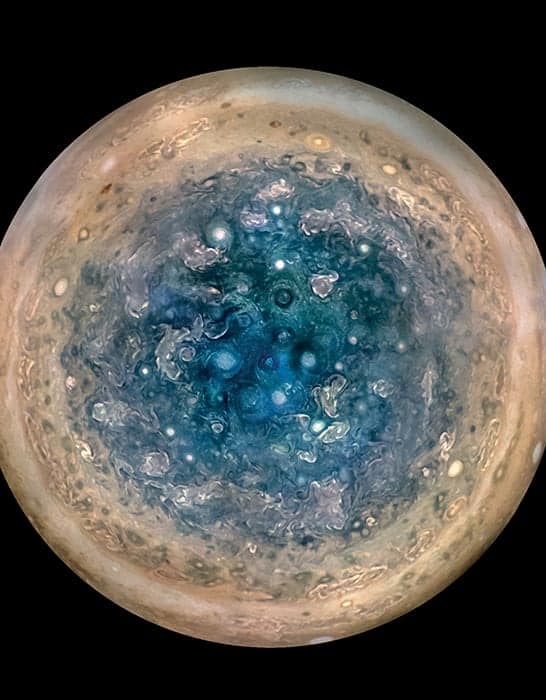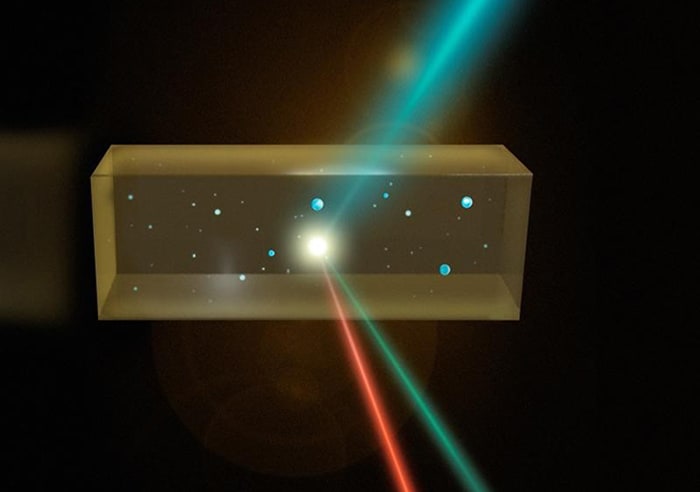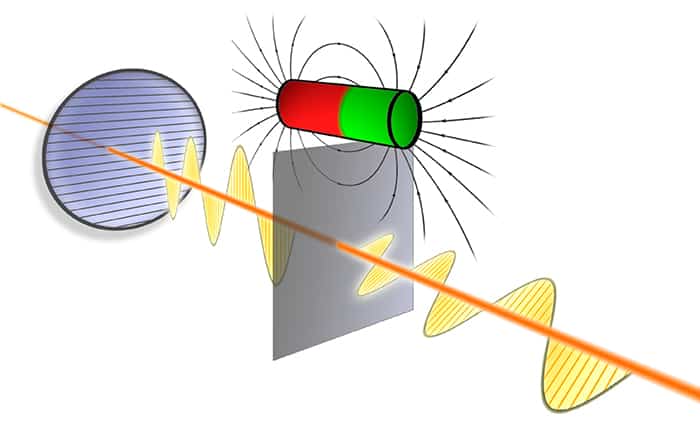Flash Physics is our daily pick of the latest need-to-know developments from the global physics community selected by Physics World‘s team of editors and reporters
Juno’s stunning portrait of Jupiter shows swirling storms

NASA’s Juno mission has sent back stunning images of Jupiter’s poles. The above image shows the gas-giant’s south pole. The spacecraft’s JunoCam instrument took multiple pictures from an altitude of 52,000 km on three separate orbits, allowing researchers to create full enhanced colour projection. The images of both poles reveal that they are covered in Earth-sized swirling storms up to 1000 km across, but do not look like each other. “We’re questioning whether this is a dynamic system, and are we seeing just one stage, and over the next year, we’re going to watch it disappear, or is this a stable configuration and these storms are circulating around one another?” explains Juno’s principal investigator Scott Bolton. As well as the images, Juno sent back a huge array of results from its first data-collection pass. They are presented in two Science papers and 44 papers in Geophysical Research Letters. “There is so much going on here that we didn’t expect, that we have had to take a step back and begin to rethink this as a whole new Jupiter,” says Bolton.
Small water droplets show unexpected order

Tiny water drops have surprisingly ordered surfaces, according to Sylvie Roke from École Polytechnique Fédérale de Lausanne (EPFL) in Switzerland and colleagues. The team looked at droplets with a diameter of around 200 nm. Such nanoscale beads of water are everywhere – in the air, rocks, oil fields and even our bodies – and therefore understanding their behaviour may provide insights into atmospheric, geological and biological processes. To study the tiny droplets, the scientists look at how their curved surfaces interact with the surrounding water-repellent environment. “The method involves overlapping ultrashort laser pulses in a mixture of water droplets in liquid oil and detecting photons that are scattered only from the interface,” explains Roke. “These photons have the sum frequency of the incoming photons and are thus of a different colour. With this newly generated colour we can know the structure of only the interface.” The team discovered that the surfaces of these tiny pockets of water at room temperature are much more ordered than that of normal water. The enhanced tetrahedral structure is instead comparable to super-cooled water – liquid water below the freezing point – which has very strong hydrogen bonds between the water molecules. The results, presented in Nature Communications, suggest the nano-droplets may have reduced reactivity, and further studies will investigate how this affects real-world systems.
Study places limit on a “fifth force”
A new way of working out whether a “fifth force” exists has been developed by an international team led by Andrea Ghez and Aurélien Hees at the University of California, Los Angeles. The group looked at the motions of two stars (S0-2 and S0-38), which orbit the supermassive black hole (SMBH) at the centre of the Milky Way. The stars were monitored for 19 years, which is roughly the time it takes the stars to complete an orbit of the SMBH. The team looked for deviations from the trajectories predicted by Einstein’s general theory of relativity, and no discrepancies were seen. This suggests that the strength of a fifth force is less than 1.6% the strength of gravity. Modern physics includes four forces: gravity, and the electromagnetic, strong and weak forces. A hypothetical fifth force appears in some theories that try to unify gravity with quantum mechanics or to explain dark matter and dark energy. While much stronger exclusions of a fifth force have already been obtained by studying forces on masses on Earth and also on objects within the solar system, this is the first study to look at large objects in the huge gravitational field of a SMBH. Writing in Physical Review Letters, Ghez, Hees and colleagues point out that their measurement should be improved next year when one of the stars makes its closest approach to the SMBH, where a deviation from general relatively could be strongest.
Topological magnetoelectric effect rotates light
A new interaction between light and a material has been observed by physicists in Austria and Germany. The team shone a polarized beam of terahertz electromagnetic radiation through a thin film that included a topological insulator in an applied magnetic field. The researchers found that the polarization of the beam is rotated by a specific angle as it travels through the material. At first glance, this rotation is similar to the well-known magneto-optical effect that occurs when light passes through a magnetic material. However, Andrei Pimenov and colleagues at the Technical University of Vienna and the University of Würzburg found that the angle is independent of the thickness of the topological insulator – which is not the case for the magneto-optical effect. Furthermore, they found that the angle is fixed at a specific value that is related to the fine-structure constant. This is a dimensionless quantity that defines the strength of the electromagnetic interaction. According to the team, the polarization is rotated by a fixed value every time it passes through a surface of the topological insulator. The researchers say this is related to the peculiar properties of a topological insulator, which is an electrical conductor at its surfaces but an insulator in the bulk. Writing in Nature Communications, the team says that this “topological magnetoelectric effect” could provide a way of defining three basic physical constants that are related to the fine structure constant: the charge of the electron, the speed of light and the Planck constant.




